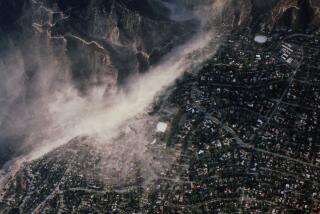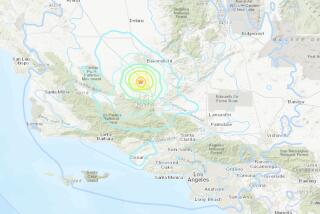Twisters in Orange County? Say It Isn’t So, Toto
- Share via
It didn’t produce enough destruction to merit a scene in the movie “Twister,” but the Great Lake Forest Tornado of 1993 left residents terrified, not to mention surprised.
The tornado roared into the Lake Forest Keys community without warning at the dinner hour on Jan. 17, tearing roofs off homes, flinging boats out of a man-made lake and propelling a woman 75 feet through the air.
No one was seriously hurt, but the twister left piles of debris and uprooted trees in its path--transforming the manicured neighborhood into a mangled disaster area.
“It was like a train running through the middle of the lake,” recalls resident Roy Farmer, whose son’s nearby home had its patio ripped off. “I was born and raised in California, and before this, I never even thought about tornadoes.”
Farmer isn’t alone. While Orange County is preoccupied with earthquakes, fires and mudslides, experts said that twisters also pose a surprisingly real threat from Mother Nature.
The county experiences an average of one tornado per year, usually during winter months when Pacific storms batter the coast. Southern California twisters aren’t as powerful as the destructive Kansas and Oklahoma variety, but they form in more populated areas where the risk of property damage and injuries is greater.
“These aren’t tornadoes like in ‘Twister.’ But they occur in urbanized centers so they are going to hit something,” said Warren Blier, an assistant professor of atmospheric science at UCLA and one of the few experts on Pacific tornadoes.
“It’s a tricky thing. We don’t want to overstate the hazard because this is not the most dangerous natural disaster people here should be worried about,” Blier added. “But people should be aware that the risk is there.”
A large swath of the Los Angeles basin including much of central Orange County seems especially susceptible to twisters, possibly because the region is not protected by coastal hills.
Buena Park, Irvine, Santa Ana and Huntington Beach have each experienced at least two twisters over the 30 years. One of the county’s worst touched down in southeast Santa Ana on Jan. 31, 1979, blowing awnings and facades off Main Street shops, flattening garages and tumbling rows of palm trees.
Most California tornadoes originate in the Pacific as winter thunderstorms. As some storms approach the coast, cold air above the ocean mixes with warmer air on land, resulting in the kind of climate instability that can cause tornadoes, according to Steve Pryor, a meteorologist with WeatherData Inc., which provides forecasts for The Times.
The weather phenomenon produces relatively mild “F-0” and “F-1” tornadoes, which pack winds of from 40 mph to 117 mph and are capable of downing trees, yanking mobile homes off their foundations and damaging roofs.
On rare occasions, Southern California experiences an “F-2” twister with winds of 113 mph to 157 mph and the power to demolish mobile homes and lift small objects.
By contrast, the Midwest produces catastrophic “F-4” and “F-5” events with winds of more than 300 mph that usually destroy all structures in their paths, Pryor said.
But those who have experienced the weaker Pacific tornadoes attest to their power. Farmer noted that the 1993 Lake Forest twister sent a piece of wood crashing through his son’s bedroom window. The impact was so great that it embedded shards of glass deep into the bedroom’s drywall.
“If he had been in the bedroom when it happened, that would have been all she wrote,” Farmer said.
Pacific tornadoes are more difficult to detect on radar than the larger Midwest storms, making it harder for officials to provide advance warning.
Mobile homes are especially vulnerable to damage during even small twisters because they are weakly constructed, said Roger Wakimoto, a meteorology professor at UCLA. Cars also are at risk because air can get under vehicles and lift them “like an airplane wing,” he added.
“Any tornado is dangerous,” Wakimoto said. “I’ve seen F-0 and F-1 tornadoes kill people in the Midwest.”
One of the safest places to be when a twister touches down is in the bathroom, because it is fortified with water pipes.
Meteorologists said they are not aware of any deaths related to Southern California twisters. But given the density of the region, they believe a tragedy is all but certain to occur one day.
“We’ve been lucky so far,” Blier said. “But my feeling is that will eventually change.”
(BEGIN TEXT OF INFOBOX / INFOGRAPHIC)
Twister Time
Orange County experiences an average of one tornado a year. Here is a list of some of the more destructive twisters that have hit here:
*--*
Date Location Dec. 3, 1880 Anaheim April 5, 1924 Huntington Beach Jan. 18, 1935 Santa Ana Nov. 7, 1966 Santa Ana Dec. 19, 1967 Santa Ana March 4, 1970 Irvine April 19, 1972 Lemon Heights March 16, 1977 Fullerton Jan. 31, 1979 Santa Ana, Anaheim Jan. 17, 1988 South County March 27, 1991 Huntington Beach Dec. 29, 1991 Buena Park March 20, 1992 Irvine Dec. 7, 1992 Anaheim, Westminster Jan. 14, 1993 Buena Park Jan 17, 1993 Lake Forest
*--*
Source: Times reports; Researched by SHELBY GRAD / For The Times
Los Angeles Times
More to Read
Sign up for Essential California
The most important California stories and recommendations in your inbox every morning.
You may occasionally receive promotional content from the Los Angeles Times.











